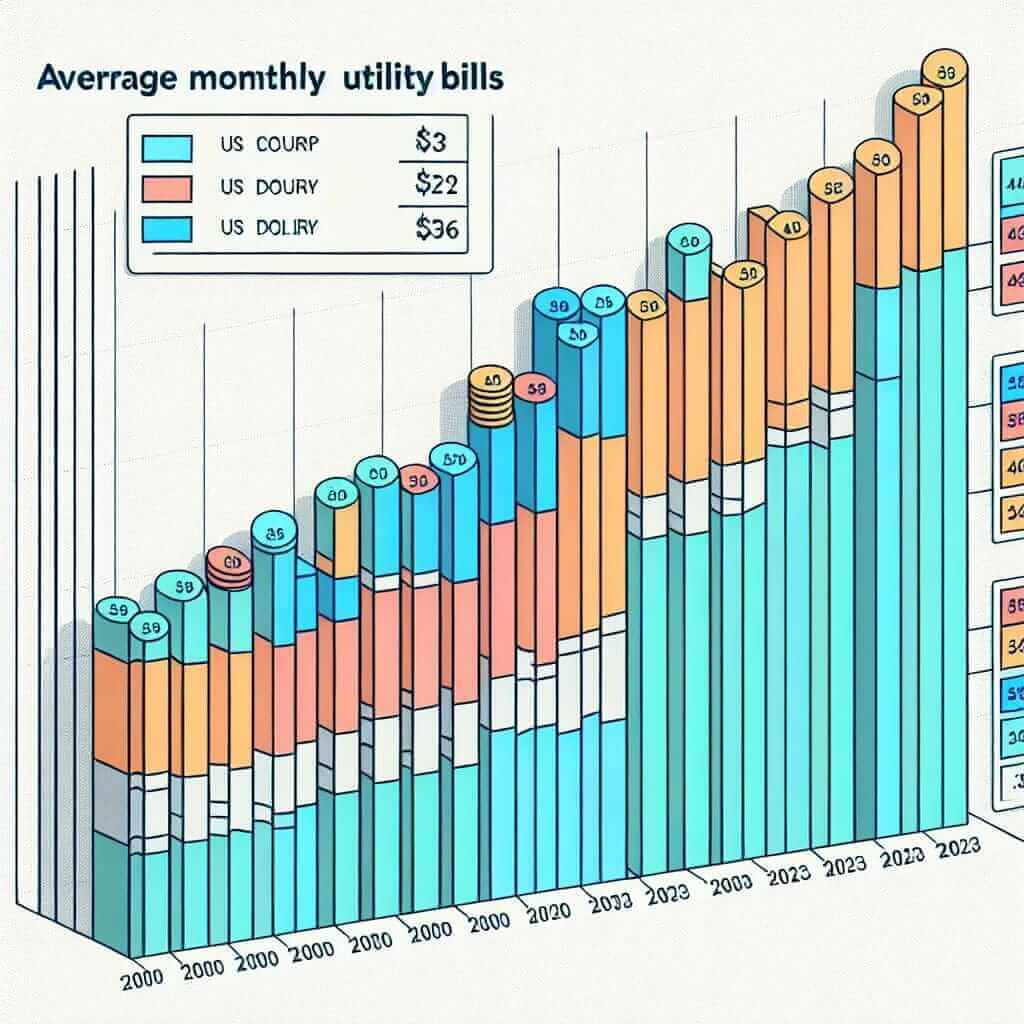Understanding “Average Monthly Utility Bills (2000-2023)” is crucial for IELTS Writing Task 1, especially given the increase in topics related to data trends and analysis. Students might encounter tasks requiring them to describe and compare data over extended periods, epitomizing this topic.
In this article, we’ll explore this topic comprehensively, offering practice topics, a sample question, an in-depth analysis, a complete sample answer, and valuable insights on vocabulary and grammar.
Let’s start by examining three sample topics related to our primary keyword:
- The graph below shows the average monthly utility bills in three different countries from 2000 to 2023. Summarize the information by selecting and reporting the main features and make comparisons where relevant.
- The table illustrates the average monthly expenses on utility bills in urban and rural areas of a particular country between 2000 and 2023. Summarize the information and make comparisons where relevant.
- The chart below gives information about average monthly utility bills in the USA from 2000 to 2023. Summarize the information and make comparisons where relevant.
Delving into an Example: Average Monthly Utility Bills (2000-2023) in Three Different Countries
Data and Chart Creation
Let’s consider the first sample question. Here is a hypothetical bar graph representing the average monthly utility bills in three countries from 2000 to 2023:
| Year | Country A | Country B | Country C |
|------|-----------|-----------|-----------|
| 2000 | $120 | $95 | $110 |
| 2005 | $130 | $105 | $115 |
| 2010 | $140 | $110 | $120 |
| 2015 | $160 | $115 | $130 |
| 2020 | $180 | $120 | $140 |
| 2023 | $200 | $125 | $150 |
Analyzing the Example
Our task is to describe the graph and make comparisons. Here are the key points:
-
Trends Over Time
- Country A: A steady increase from $120 in 2000 to $200 in 2023.
- Country B: A moderate rise from $95 in 2000 to $125 in 2023.
- Country C: A gradual increase from $110 in 2000 to $150 in 2023.
-
Comparison Among Countries
- 2000-2010: Country A consistently had the highest bills while Country B had the lowest.
- Post-2010: The gap widens with Country A’s bills rising significantly more than the other two countries.
Sample Answer: Average Monthly Utility Bills (2000-2023)
The graph compares the average monthly utility bills in three countries—Country A, Country B, and Country C—over 23 years, from 2000 to 2023. Overall, there is a clear upward trend in utility expenses in all three countries, though the rate of increase varies.
At the start of the period, Country A had the highest average monthly bill, at $120, followed by Country C and Country B, where expenses were $110 and $95, respectively. By 2023, Country A’s utility bills had surged to $200, marking an 80-point increase. During the same period, Country B’s utility costs rose modestly to $125 and Country C’s to $150.
A noticeable aspect is the accelerating pace of increase in Country A starting around 2010. In contrast, both Country B and Country C experienced steadier, more gradual rises over the years. Although Country B started with the lowest utility bills, it managed to maintain relatively lower expenses throughout the examined period.
In conclusion, while all three countries have seen significant increases in their utility bills, Country A exhibits the most pronounced rise. This highlights varying economic conditions and perhaps different levels of reliance on utilities across these countries.
Word Count: 203
Key Considerations for Writing
-
Vocabulary and Grammar:
- Descriptive Verbs: surged, rose, increased.
- Comparative Structures: higher than, lower than, the highest, the lowest.
- Chronological Descriptors: by 2023, at the start of the period, during the same period.
-
Useful Vocabulary:
- Significant (adj) /ˈsɪɡ.nɪ.fɪ.kənt/ – important and meaningful.
- Moderate (adj) /ˈmɒd.ər.ət/ – average in amount, intensity, quality, or degree.
- Gradual (adj) /ˈɡrædʒ.u.əl/ – taking place or progressing slowly.
- Consistently (adv) /kənˈsɪs.tənt.li/ – in a systematic manner over a period.
- Noticeable (adj) /ˈnəʊ.tɪ.sə.bəl/ – easily seen or noticed.
Conclusion
To excel in IELTS Writing Task 1, particularly when dealing with topics like average monthly utility bills, it is essential to adeptly describe trends, make comparisons, and use precise vocabulary and grammar. Practice regularly, analyze tasks comprehensively, and keep refining your language skills.
Keep these strategies in mind, and achieving a Band 7+ will become more attainable.